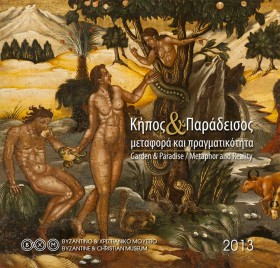2013
Garden & Paradise. Metaphor and Reality. Athens 2013
The choice of subject-matter for this year’s diary stems directly from the proposals submitted for the remodelling of the Museum grounds. As it does every year, however, the 2013 diary will also constitute a mini museum in its own right, granting insights into and shedding light on the Museum’s collections. Perusing the artefacts presented within its covers, the reader can embark on their own search for paradise...
Now that the exhibition of the Museum’s permanent collections is complete and the Duchess of Plaisance’s mansion has been inaugurated as a new exhibition space, the Byzantine and Christian Museum can address another pressing obligation: the remodelling of its grounds and their opening to the public. The Museum grounds cover some 2,000 square metres, and the museological approach informing their remodelling would have to be compatible with the nature, mission and aims of our historical museum, which is celebrating its centenary in 2013. Accordingly, we set out to offer our visitors the experience of a multi-functional open air park in the heart of Athens as part of their visit.
We looked to the Byzantine perception of nature, gardens, springs and the landscape to provide the starting point for our study. The lyrical descriptions of the natural landscape included in Byzantine ekphraseis and rhetoric provided valuable literary insights into the concept of a garden as paradise/Eden and into its multiple symbolisms: the walled garden, the tree of life, the gushing fountain as a source of life and wisdom. And while such descriptions may be overly flowery and excessive on occasions, they nonetheless reflect the enduring Byzantine interest in the natural landscape. In turn, the paradisal landscapes depicted in Byzantine art, primarily in mosaics and illuminated manuscripts, afforded us a valuable archaeological account of the walled imperial and monastic gardens of the Byzantine era. A number of obvious analogies can be drawn between gardens and paradise: the Byzantines certainly identified their recreational gardens, which were often sited beside rivers, with paradise, and this duality of meaning—the Greek word ðáñÜäåéóïò denoting ‘Paradise’, but also ‘Heaven’, ‘Eden’ and thence ‘garden’—explains how the garden came to occupy a central place in numerous symbolisms central to the Byzantine worldview.
COORDINATION
Anastasia Lazaridou
ACADEMIC SUPERVISION – TEXTS
Elena Papastavrou
EDITOR
Jasmin Moysidou
ENGLISH TRANSLATION
Michael Eleftheriou – Jasmin Moysidou
PHOTOGRAPHS
Andronikos Chatzikostis, Charis Psychopaidi
GRAPHIC DESIGNER
Yannis Stavrinos
DESIGN SUPPORT
Giorgos Soupios
PRINTING
REGISTER – Petros Kalamatianos
 |








